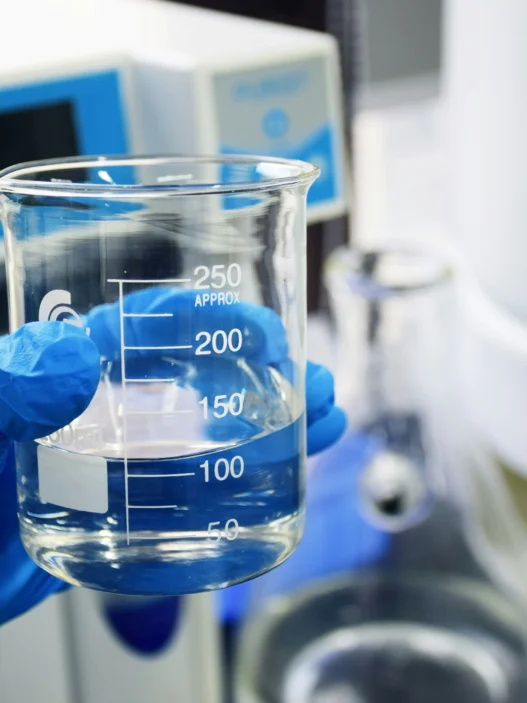Pyridoxamine is a form of vitamin B6 that plays a crucial role in various metabolic processes in the human body. This essential nutrient is involved in the synthesis of vital compounds, such as amino acids and neurotransmitters, and is necessary for the proper functioning of the nervous system, immune system, and cardiovascular system. Its relevance to everyday life lies in its ability to support overall health and well-being, helping to maintain energy levels, cognitive function, and optimal bodily functions. Incorporating foods rich in pyridoxamine or taking supplements can help ensure sufficient intake of this important vitamin for individuals of all ages.
Table of Contents:
- 💡 Commercial Applications
- ⚗️ Chemical & Physical Properties
- 🏭 Production & Procurement
- ⚠️ Safety Considerations
- 🔬 Potential Research Directions
- 🧪 Related Compounds
💡 Commercial Applications
Pyridoxamine, a form of vitamin B6, has several commercial and industrial applications. It is commonly used as a dietary supplement to aid in energy metabolism and the synthesis of neurotransmitters. Pyridoxamine is also utilized in the production of animal feed to enhance growth and overall health in livestock.
In the realm of drug and medication applications, pyridoxamine has shown promise in the treatment of diabetic nephropathy and other complications of diabetes. Research suggests that pyridoxamine may help reduce inflammatory markers and protect against the progression of kidney damage in diabetic patients. Additionally, pyridoxamine has been studied for its potential anti-inflammatory effects in conditions such as arthritis and cardiovascular disease.
⚗️ Chemical & Physical Properties
Pyridoxamine is a white to pale yellow crystalline powder with no distinct odor, making it practically odorless.
With a molar mass of 168.188 g/mol and a density of 1.235 g/cm3, pyridoxamine is similar in molar mass to common household items such as table salt and baking soda, but has a higher density compared to these substances.
Pyridoxamine has a melting point of approximately 192°C and a boiling point of around 450°C. These properties are higher than those of common household items like sugar and butter, which have lower melting and boiling points.
Pyridoxamine is highly soluble in water and has a relatively low viscosity. This makes it more soluble in water and less viscous compared to substances like oil and honey commonly found in households.
🏭 Production & Procurement
Pyridoxamine, a form of vitamin B6, is typically produced through chemical synthesis in a laboratory setting. This process involves reactions between pyridoxal and ammonia or hydroxylamine, followed by crystallization and purification steps to obtain the final product in an isolated form.
Pyridoxamine can be procured from various chemical suppliers and pharmaceutical companies that specialize in the production of vitamins and dietary supplements. The compound is typically packaged in powder or capsule form for ease of handling and shipping. Transporting Pyridoxamine can be done via standard shipping methods, such as air or ground transportation, with proper precautions taken to ensure product integrity and stability during transit.
For large-scale production, Pyridoxamine may also be sourced from contract manufacturers who specialize in chemical synthesis and formulation services. These organizations have the expertise and capabilities to produce Pyridoxamine in bulk quantities, which can then be distributed to clients for further processing or incorporation into various products. The procurement and transportation of Pyridoxamine are essential steps in ensuring its availability for use in pharmaceuticals, dietary supplements, and other applications that require this important vitamin B6 derivative.
⚠️ Safety Considerations
Safety considerations for Pyridoxamine include its potential to cause skin and eye irritation. It is advised to handle this substance with care and to avoid contact with skin and eyes. In case of contact, rinse thoroughly with water and seek medical advice immediately.
Pyridoxamine, a form of vitamin B6, acts as a coenzyme in various metabolic reactions in the body. It plays a crucial role in the metabolism of amino acids and neurotransmitters, as well as in the synthesis of hemoglobin and DNA. Pyridoxamine is essential for proper nerve function and the production of red blood cells.
Hazard statements for Pyridoxamine include its irritant properties, which can cause skin and eye irritation upon contact. It is also important to avoid inhalation and ingestion of this substance to prevent potential health hazards. Adequate safety measures, such as wearing protective gloves and goggles, should be taken when handling Pyridoxamine.
Precautionary statements for Pyridoxamine include storing the substance in a cool, dry place away from direct sunlight. It is important to keep Pyridoxamine out of reach of children and pets to prevent accidental ingestion. In case of exposure, it is recommended to seek medical advice immediately and to provide the medical professional with detailed information about the substance.
🔬 Potential Research Directions
Pyridoxamine, a form of vitamin B6, has shown promise as a potential therapeutic agent in various medical conditions. Future research in this area could focus on investigating the mechanisms of action of pyridoxamine at a molecular level, to better understand how it exerts its biological effects.
Furthermore, studies could explore the efficacy of pyridoxamine in different disease models, such as diabetes, kidney disease, and inflammation. By elucidating the specific pathways and targets through which pyridoxamine acts, researchers may uncover novel therapeutic opportunities for this vitamin B6 derivative.
Moreover, clinical trials could be conducted to assess the safety and effectiveness of pyridoxamine in human subjects. This would provide valuable insights into the potential benefits of pyridoxamine supplementation in managing various health conditions, paving the way for its use in personalized medicine approaches.
🧪 Related Compounds
One similar compound to Pyridoxamine is Pyridoxal, which shares a similar molecular structure. Pyridoxal is an aldehyde form of vitamin B6 and plays a crucial role in various enzymatic reactions in the body. It is essential for amino acid metabolism and neurotransmitter synthesis.
Another compound similar to Pyridoxamine is Pyridoxine, also known as vitamin B6. Pyridoxine is essential for the metabolism of proteins, carbohydrates, and fats. It is involved in the production of red blood cells and neurotransmitters, making it crucial for overall health.
Pyridoxal phosphate is another compound similar to Pyridoxamine. As the active form of vitamin B6, pyridoxal phosphate serves as a coenzyme in various enzymatic reactions. It plays a crucial role in neurotransmitter synthesis, amino acid metabolism, and the production of hemoglobin. Pyridoxal phosphate is essential for overall health and well-being.





